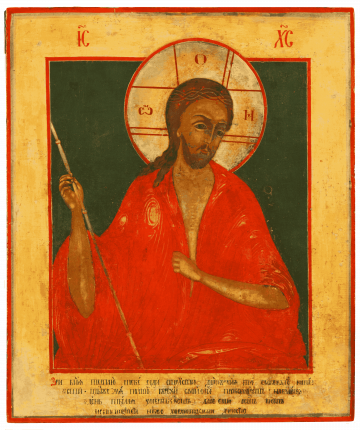Christ - "King of the Jews"
(Russia; eighteenth century)
Russia; eighteenth century; 31.7 x 26.8 cm
Feast: Good Friday
Iconography
The theme of depicting Christ as the Jewish king, be it as a full-body figure, up to the knees or up to the waist, dressed in a scarlet cloak, with a thorn wreath on his head and a cane in his hand, comes from the Western Church, being especially popular and widespread in the late Middle Ages. Such depictions were based on the themes of the sufferings of Jesus Christ, described in the Gospel (cf. Matthew 27:27-30).
Description of the icon
The Son of God is present on the icon at the moment when Pilate brought him before the Jews and declared, “Behold the Man!” In Latin, “Ecce Homo!” (John 19:5), and also when he said of him before the Jews, “Your King!” (John 19:14), which is confirmed by the inscription that Pilate ordered to be made and affixed to the cross, “Jesus of Nazareth, King of the Jews” (John 19:19).
He is depicted as suffering, whipped and crowned with thorns. In order to humiliate Christ as much as possible, the Jews marked him with derogatory symbols of power. He has a military scarlet cloak draped over his shoulders which was used to cover convicts after a whipping. He has a thorn wreath (crown) on His head and a reed instead of a king's sceptre in the right hand, for mockery and humiliation. He holds the edge of his cloak with his left hand to cover his nudity. There is a nimbus around his head with an inscribed cross and the Greek letters Ѡ Ѻ N, which are symbols of God's name “I am who I am.” We see the suffering he went through, the humiliation, pain and sorrow in Christ’s face. In silence, with his head bowed humbly, he is standing in front of a crowd shouting “Crucify!” The two strands of hair on his left shoulder symbolize the Old and New Testaments, as well as His Divine and human nature.
There is an ecclesial Slavonic text, which corresponds to the scene of the suffering of Christ for the salvation of the human race, at the bottom of the icon. The approximate translation of the difficult-to-read text is as follows: “Look at the suffering I am going through in order to save you from the pitfalls of hell. So why do you stab me every day with your sins? You're killing me, child. But I would rather take the cross and accept death than I would constantly suffer for your sins.”


